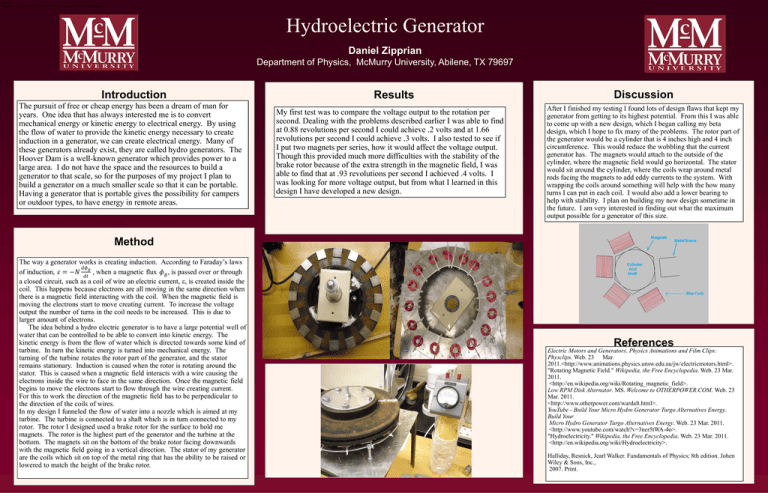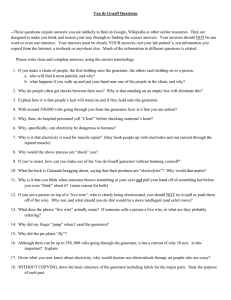posters - McMurry University
advertisement

Table 2 Summary of Age, Gender, Ethnicity, Family Size, and Seriousness of Current Relationship Hydroelectric Generator Daniel Zipprian Department of Physics, McMurry University, Abilene, TX 79697 Introduction The pursuit of free or cheap energy has been a dream of man for years. One idea that has always interested me is to convert mechanical energy or kinetic energy to electrical energy. By using the flow of water to provide the kinetic energy necessary to create induction in a generator, we can create electrical energy. Many of these generators already exist, they are called hydro generators. The Hoover Dam is a well-known generator which provides power to a large area. I do not have the space and the resources to build a generator to that scale, so for the purposes of my project I plan to build a generator on a much smaller scale so that it can be portable. Having a generator that is portable gives the possibility for campers or outdoor types, to have energy in remote areas. Results My first test was to compare the voltage output to the rotation per second. Dealing with the problems described earlier I was able to find at 0.88 revolutions per second I could achieve .2 volts and at 1.66 revolutions per second I could achieve .3 volts. I also tested to see if I put two magnets per series, how it would affect the voltage output. Though this provided much more difficulties with the stability of the brake rotor because of the extra strength in the magnetic field, I was able to find that at .93 revolutions per second I achieved .4 volts. I was looking for more voltage output, but from what I learned in this design I have developed a new design. Discussion After I finished my testing I found lots of design flaws that kept my generator from getting to its highest potential. From this I was able to come up with a new design, which I began calling my beta design, which I hope to fix many of the problems. The rotor part of the generator would be a cylinder that is 4 inches high and 4 inch circumference. This would reduce the wobbling that the current generator has. The magnets would attach to the outside of the cylinder, where the magnetic field would go horizontal. The stator would sit around the cylinder, where the coils wrap around metal rods facing the magnets to add eddy currents to the system. With wrapping the coils around something will help with the how many turns I can put in each coil. I would also add a lower bearing to help with stability. I plan on building my new design sometime in the future. I am very interested in finding out what the maximum output possible for a generator of this size. \ Method Table 2 Summary of Age, Gender, Family Size, and Seriousness of Current Relationship References Electric Motors and Generators. Physics Animations and Film Clips: Physclips. Web. 23 Mar. 2011.<http://www.animations.physics.unsw.edu.au/jw/electricmotors.html>. "Rotating Magnetic Field." Wikipedia, the Free Encyclopedia. Web. 23 Mar. 2011. <http://en.wikipedia.org/wiki/Rotating_magnetic_field>. Low RPM Disk Alternator. MS. Welcome to OTHERPOWER.COM. Web. 23 Mar. 2011. <http://www.otherpower.com/wardalt.html>. YouTube - Build Your Micro Hydro Generator Turgo Alternatives Energy. Build Your Micro Hydro Generator Turgo Alternatives Energy. Web. 23 Mar. 2011. <http://www.youtube.com/watch?v=3ner5tWA-4o>. "Hydroelectricity." Wikipedia, the Free Encyclopedia. Web. 23 Mar. 2011. <http://en.wikipedia.org/wiki/Hydroelectricity>. Halliday, Resnick, Jearl Walker. Fundamentals of Physics; 8th edition. Johen Wiley & Sons, Inc., 2007. Print.



